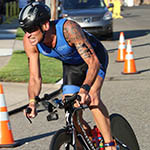We don't want to hear excuses.
So you don't have the fancy virtual reality indoor trainer program, fine. We can fix that. These five workouts will keep you entertained in the saddle, raise your heart rate through the roof and challenge you to be your best. And they only take 60 minutes.
If you already use a power meter and/or a heart rate monitor while you train on the bike, then you may already know about training terminology like FTP (Functional Threshold Power) and AT (Aerobic Threshold). These workouts will rely on some technology to help you gauge and record your efforts.
If you don't have any of these high-tech training toys, don't sweat it, just go by feel, or RPE (Rate of Perceived Exertion).


